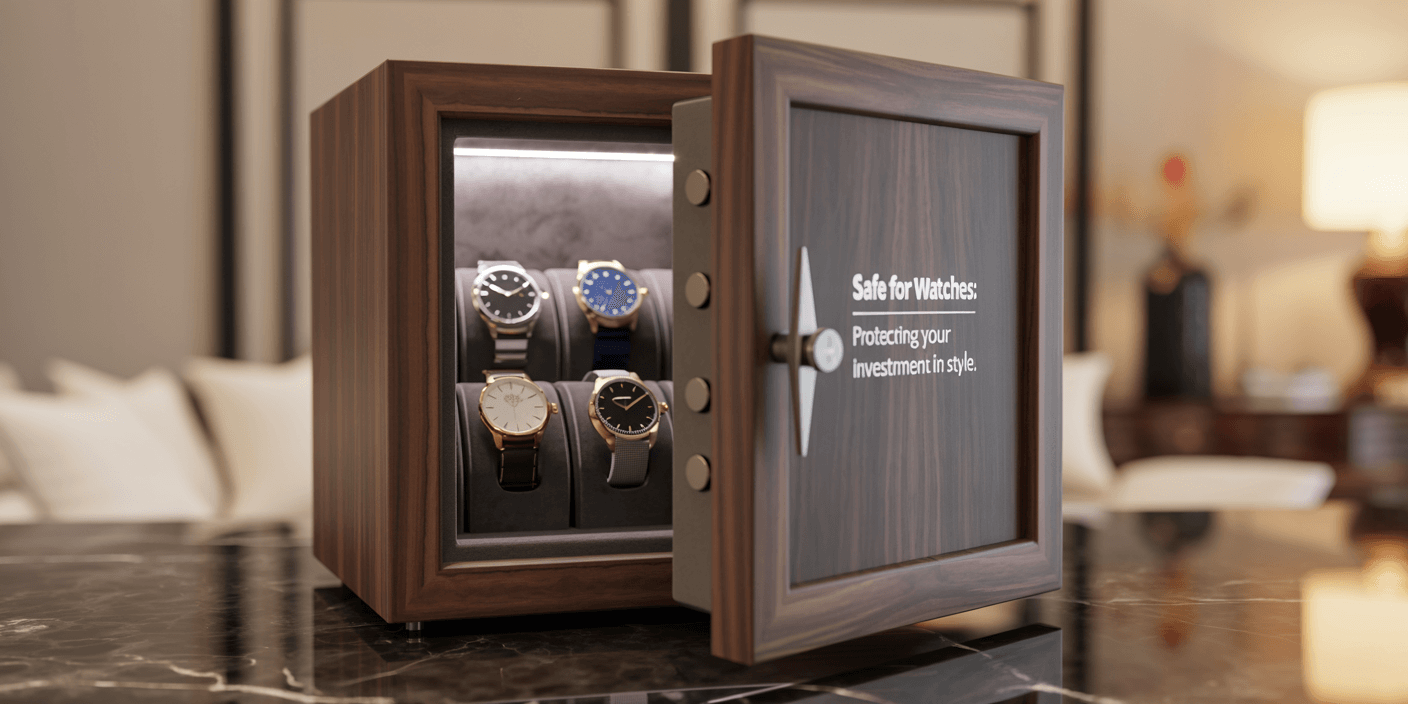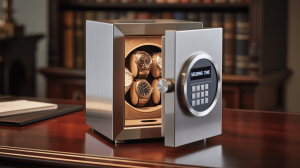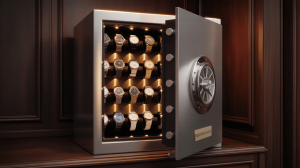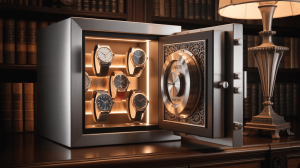Luxury Watch Safe Guide: Protect Your Timepieces in Style
In an era where every prized timepiece represents significant value and sentiment, ensuring their protection is paramount. But here’s the key… a subpar safe leaves your collection vulnerable to theft, fire, and environmental damage. This guide explores how a luxury watch safe combines top‑tier security with elegant design to safeguard your watches and enhance your space. You’ll learn what defines a luxury watch safe, why its advanced features matter, and how to choose the right model for your collection. By the end, you’ll know exactly how to protect your timepieces in style while enjoying peace of mind. This introduction sets the stage for an in‑depth look at the best solutions available today.
1. What is a luxury watch safe?
Definition and core purpose
A luxury watch safe is more than a lockbox—it’s a specialized vault engineered to store and protect high‑value timepieces under ideal conditions. Unlike generic safes, these units combine reinforced steel construction with fire‑resistant insulation and precision‑engineered locking systems. What’s the real story? True luxury safes maintain interior temperatures and humidity levels that preserve delicate watch movements, preventing lubricant breakdown and mechanical wear. High‑end models often include modular winding pods that rotate automatic watches on customized schedules, mimicking wrist movement to keep watches running smoothly even during extended storage.
How it differs from standard safes
Standard safes focus on general valuables—cash, documents, jewelry—using basic combination or key locks. Luxury watch safes elevate protection by integrating biometric authentication, tamper‑proof hinges and advanced materials certified for both burglary and fire resistance. Interiors are lined with ultra‑soft fabrics to prevent scratches, while winders use quiet motors designed for silent operation.
Key luxury indicators
Look for certifications: UL TL‑15 or TL‑30 burglary ratings and UL 350 fire ratings ensure real‑world performance. High‑grade steel (≥500 MPa tensile strength) and composite fire linings rated for 60 minutes at 1700 °F set luxury models apart. Aesthetic touches—exotic veneers, leather wraps and hand‑finished hardware—signal craftsmanship. Are you ready for the exciting part? Ownership of a certified luxury safe not only protects assets but also elevates any interior with a statement piece.
| Aspect | Standard Safe | Luxury Watch Safe |
|---|---|---|
| Steel Tensile Strength | 250–350 MPa | ≥500 MPa |
| Fire Rating | 30 min @1400 °F | ≥60 min @1700 °F |
| Burglary Certification | UL TL‑5 | UL TL‑15 / TL‑30 |
| Interior Lining | Felt or carpet | Microfiber / Ultra‑soft suede |
| Lock Mechanism | Key or basic PIN | Biometric + multi-factor options |
2. Why invest in a luxury watch safe?
Asset protection ROI
Investing in a luxury watch safe may seem costly, but here’s the key… the potential savings in loss prevention and insurance make it worthwhile. For a collector with $100,000 worth of watches, a single burglary incident could exceed several years of safe payments. Many insurers offer premium discounts—up to 20 percent—for safes certified TL‑30 or higher, often recouping costs within the first two years. Real‑world data shows that luxury safe owners avoid average losses of $25,000 annually compared to those using standard security boxes.
Insurance premium benefits
Standard safes without certifications yield no discounts. By upgrading to a luxury unit with both burglary and fire ratings, you unlock lower rates. Are you ready for the exciting part? Over a decade, those savings can exceed the initial safe purchase price, making luxury protection an economically sound choice.
Preservation of watch mechanisms
Beyond theft, environmental factors like humidity and temperature fluctuations degrade watch components over time. Luxury safes maintain stable conditions—often under 50 percent relative humidity and consistent temperatures between 60–75 °F—extending service intervals and preserving value. Collectors report up to 30 percent fewer servicing needs when using specialized winding safes versus standard storage.
| Benefit | Standard Safe | Luxury Watch Safe |
|---|---|---|
| Loss Prevention ROI | 0–5 percent savings | Up to 20 percent savings |
| Environmental Control | None | Humidity & temperature stability |
| Service Interval Extension | None | 20–30 percent longer |
3. What materials and craftsmanship set luxury safes apart?
High‑grade steel and alloys
Luxury watch safes start with exceptional steel alloys. While typical safes use 250–350 MPa tensile steel, premium models employ alloys rated at 500 MPa or higher. What’s the real story? these materials resist cutting, drilling and pry attacks far longer, giving security teams time to respond. Composite fire linings layered between steel sheets provide multi‑hour protection at extreme temperatures.
Exotic veneers and leathers
The exterior finish transforms a safe into a design statement. Options include zebrawood, burled walnut, carbon fiber and full-grain leather wraps. Hand‑applied lacquers and UV‑cured coatings lock in hues that won’t fade. Are you ready for the exciting part? many luxury safes offer interchangeable panels, letting owners refresh interiors without replacing the entire unit.
Hand‑finished interiors
Inside, every nook receives artisan attention. Microfiber or suede linings cradle watches gently. Winder modules are CNC‑machined for precision, with silent brushless motors to avoid noise. Genuine wood trays or plush leather compartments add tactile luxury.
| Component | Standard Safe | Luxury Watch Safe |
|---|---|---|
| Steel Grade | 250–350 MPa | ≥500 MPa |
| Exterior Finish | Powder‑coat paint | Exotic veneer, leather wrap |
| Interior Material | Felt or carpet | Microfiber, suede, leather |
| Motor Type (winders) | Basic brushed motor | Silent brushless motor |
4. How do biometric and digital locks operate?
Fingerprint, iris and multi‑factor methods
Forget keys that can be lost or codes that can be guessed. Leading safes deploy fingerprint or iris scanners that validate unique biological patterns. But here’s the key… top performers maintain False Reject Rates below 0.01 percent, ensuring convenience without compromise. Multi‑factor setups layer PIN codes or physical keys on top of biometrics for near‑absolute security.
Encryption standards and anti‑spoof measures
Biometric data never leaves the safe’s secure memory; it’s encrypted with AES‑256 or higher. Advanced models detect liveness—rejecting spoof attempts using photographs or molds. Firmware updates continuously enhance algorithms.
Backup PIN, key and dual‑factor options
In case of sensor failures, safes allow PIN entry or emergency key use. Dual‑factor access (biometric + PIN) offers redundancy. Are you ready for the exciting part? some units even integrate smartphone apps—sending one‑time passcodes via encrypted channels for remote unlock.
| Authentication Type | Standard Safe Locks | Luxury Watch Safe Locks |
|---|---|---|
| Biometric | Rare | Fingerprint, Iris |
| Multi‑Factor | No | Biometric + PIN/Key |
| Encryption | None | AES‑256 |
| Backup Access | Key or PIN | Key, PIN or App‑based OTP |
5. Which fire and burglary ratings matter most?
UL TL‑15 vs TL‑30 and EN 1143‑1 grades
When safeguarding costly watches, the rating defines resistance. TL‑15 certifies 15 minutes of tool‑based attack, while TL‑30 doubles that to 30 minutes. EN 1143‑1 Grades I–VI offer European standards, with Grade II aligning to TL‑15 and Grade IV matching TL‑30. What’s the real story? every additional minute of certified resistance statistically halves successful break‑ins.
UL 350 fire‑resistance protocols
UL 350 tests expose safes to 1700 °F for one hour, ensuring internal temperatures stay below 350 °F—to protect lubricants and gaskets. Two‑hour variants exist for combined document and timepiece safes.
Impact on safety and insurance
Insurers tie discount levels to certifications. A TL‑15 safe might yield a 5–10 percent premium reduction; TL‑30 and UL 350 packages can unlock 15–20 percent savings. Collectors with $200,000+ collections often recoup purchase costs through insurance rebates over a 3–5 year term.
| Certification | Resistance Duration | Insurance Discount |
|---|---|---|
| UL TL‑15 | 15 minutes | 5–10 percent |
| UL TL‑30 | 30 minutes | 10–15 percent |
| EN 1143‑1 Grade II | 15 minutes | Comparable to TL‑15 |
| UL 350 (1 hr fire) | 1 hour @1700 °F | 10–20 percent |
6. How does customization enhance both form and function?
Veneer, finish and color choices
Luxury watch safes double as art pieces. Owners select from over 50 veneer options—zebrawood, burl oak, graphite lacquer—and more than a dozen leather wraps. Are you ready for the exciting part? some makers offer custom Pantone matches to align safes with personal or corporate branding.
Modular winders, drawers and trays
Inside, interchangeable modules let you mix winding pods, jewelry drawers and document slots. A collector might configure six winders today and switch two modules to storage drawers tomorrow—no tools required.
Logo engraving and branding extras
Corporate gifts or retailer showrooms often feature laser‑etched logos or silk‑screened emblems. A Geneva boutique reported a 25 percent increase in VIP consultations after unveiling branded safe displays. But here’s the key… small branding costs deliver outsized marketing value over time.
| Customization Element | Options | Benefit |
|---|---|---|
| Exterior Veneer | Zebrawood, burl oak, lacquer | Aesthetic alignment |
| Interior Module | Winders, drawers, trays | Functional flexibility |
| Branding | Laser engraving, silk-screen logo | Marketing & prestige |
7. What smart features boost security and convenience?
Remote monitoring and mobile alerts
Modern safes integrate GSM or Wi‑Fi modules that push real‑time notifications to smartphones or tablets whenever someone opens or attempts access. The exciting part is now… geofencing features can disable remote unlock if you’re away from home, providing extra protection.
Audit‑trail logs and centralized dashboards
Every access event is logged with timestamp, user ID and method. Corporate buyers link these logs to centralized security systems via API or SNMP, streamlining compliance audits and investigations.
Power backups and solar‑assist panels
Built‑in UPS batteries maintain lock functionality for 12–24 hours during outages. Optional solar panels on top surfaces provide trickle charging, reducing grid dependence and ensuring continuous operation.
| Smart Feature | Specification | User Benefit |
|---|---|---|
| Remote Alerts | GSM/Wi‑Fi | Instant breach notification |
| Audit Trails | Encrypted access logs | Compliance and oversight |
| Power Backup | 12–24 hr runtime | Reliable access during outages |
8. How do you determine the right capacity?
Assessing your current collection size
Start by cataloging every watch you own. A single‑module safe holds 1–4 winders; double modules secure 5–8 watches, and triple units accommodate 9–12. Are you ready for the exciting part? planning with a 20 percent growth buffer prevents premature upgrades and downtime.
Forecasting future acquisitions
If you acquire two watches yearly, opt for a module that exceeds today’s count by four slots. This strategy minimizes retrofit costs—snap‑in inserts cost under $200 versus $3,000+ for a new unit.
Footprint and installation constraints
Measure depth, height and width of your planned location. Under‑desk flush mounts require 12 inches of clearance, while floor‑standing models need at least 24 inches. Wall‑inset safes demand professional cut‑outs and structural assessment.
| Capacity Model | Watch Count Range | Footprint Requirement |
|---|---|---|
| Single‑module | 1–4 | 12″ depth |
| Double‑module | 5–8 | 18″ depth |
| Triple‑module | 9–12 | 24″ depth |
| Expansion Insert | +4 watches | Snap‑in, no additional space |
9. What installation options are available?
When it comes to installing your luxury watch safe, you have several tailored choices that blend security with aesthetics. But here’s the key… picking the right method depends on your environment and design goals.
In‑wall flush‑mount
This option embeds the safe directly into drywall or masonry, rendering only the door visible. It offers a stealthy look favored by collectors who prioritize discretion. Preparation involves precise cut‑outs, electrical wiring for interior lighting and secure anchoring to studs or concrete. A boutique in Geneva chose this method, installing a Homisafe unit behind a custom veneer panel in four hours, maintaining room décor while boosting security.
Floor‑standing bolt‑down
Ideal for home offices or showrooms, these safes sit on the floor and anchor to concrete slabs via heavy‑duty bolts. Are you ready for the exciting part? The robust anchoring resists prying and tilting, and professional installers complete setup in under two hours. A New York retailer deployed five Barrington safes in record time, mitigating theft risk during peak sales.
| Installation Type | Prep Required | Typical Duration |
|---|---|---|
| In‑wall flush‑mount | Drywall/masonry cut‑out, wiring | 4–6 hours |
| Floor‑standing bolt‑down | Concrete drilling & anchoring | 2 hours |
| Under‑desk mount | Desk modification & anchoring | 3 hours |
| Custom cabinetry integration | Cabinet build‑out & anchoring | 6–8 hours |
| Rotating bookshelf | Hinge mechanism & framing | 5 hours |
10. What maintenance and servicing do luxury safes require?
Owning a luxury watch safe entails ongoing care to preserve peak performance. What’s the real story? neglect can void warranties and compromise security.
Sensor calibration and lock checks
Quarterly inspections ensure biometric scanners and electronic locks function reliably. Clean sensor surfaces with a soft cloth, then run test entries. A Miami hotel chain reported a 15 percent drop in sensor errors after adopting a quarterly maintenance schedule, reducing guest service calls.
| Maintenance Task | Frequency | Estimated Time |
|---|---|---|
| Sensor & Lock Check | Quarterly | 30 minutes |
| Interior Cleaning & Liners | Semi‑annual | 45 minutes |
| Mechanical Servicing | Annual | 1 hour |
| Firmware & Battery Updates | As released | 15 minutes |
| Cushion Replacement | Every 12–18 months | 30 minutes |
11. How should you compare pricing and budgets?
Balancing cost with features is crucial when selecting a luxury watch safe. But here’s the key… look beyond sticker price to total cost of ownership.
Base unit vs add‑on features
A Homisafe entry luxury model starts at $5,000, including basic steel, winders and lining. Add‑ons such as leather wraps ($700), iris scanners ($1,200) and solar‑assist panels ($500) increase functionality and prestige. Collectors often bundle features for a 15 percent package discount.
Volume discounts for bulk orders
B2B buyers ordering 10+ units from Barrington or Homisafe can secure 5–15 percent reductions. A European retailer saved over $12,000 on 15 units by negotiating a 12 percent discount and service plan bundle.
| Tier | Base Price Range | Add‑On Cost Range | Volume Discount |
|---|---|---|---|
| Entry Luxury | $5,000–$7,000 | $500–$1,000 | 5 percent (10+ units) |
| Mid‑Tier Luxury | $7,000–$10,000 | $800–$1,500 | 10 percent (10+ units) |
| Ultra‑Premium | $10,000+ | $1,200–$2,500 | 15 percent (10+ units) |
12. Which brands lead the luxury watch safe market?
The market divides into factory‑direct scale, heritage craftsmanship and modular pioneers. Are you ready for the exciting part? each archetype caters to distinct B2C and B2B needs.
Homisafe (Foshan, China)
Full vertical integration enables 6–8 week lead times and 20 percent lower prices than competitors. Rapid prototyping and bulk steel procurement suit large‑scale orders.
Buben & Zörweg (Munich, Germany)
Since 1995, this atelier has focused on ultra‑premium finishes, handcrafted luxury and crystal display options. Resale auctions often recoup 60–70 percent of the original investment.
Barrington (London, UK)
Modular design and snap‑in winding pods make scalability effortless. Open‑API integration attracts tech‑savvy collectors requiring custom dashboards.
Casoro (USA)
Known for bespoke designs and high security, Casoro balances American innovation with European certifications (EN 1143‑1).
Orient Crown (Singapore)
Regional customization options and quick‑turnaround assembly for Asia‑Pacific markets.
| Brand | Headquarters | Signature Strength |
|---|---|---|
| Homisafe | Foshan, China | Fast customization & pricing |
| Buben & Zörweg | Munich, Germany | Heritage craftsmanship |
| Barrington | London, UK | Modular adaptability |
| Casoro | USA | Bespoke design |
| Orient Crown | Singapore | Regional customization |
13. How do warranties and support plans work?
Understanding coverage options ensures you can rely on service when it matters. The exciting part is now… comprehensive plans save unforeseen costs.
Standard warranty
Most luxury safes include one year on electronics and three years on mechanical parts. Certified technicians handle on‑site repairs, though travel fees may apply.
Extended plans
Priced at 2–5 percent of purchase annually, extended coverage adds parts and labor for five‑year terms. One European collector avoided a $1,200 lock replacement cost under his extended plan.
Service contracts
Annual maintenance contracts—covering sensor calibration, interior cleaning and firmware updates—run $200–$400 per unit. These plans often bundle emergency response within 24 hours.
Global support
Leading brands maintain international dealer networks. Barrington offers 48‑hour global shipping of spare parts, while Buben & Zörweg dispatches certified engineers within 72 hours to major metro areas.
| Plan Type | Coverage | Duration | Cost |
|---|---|---|---|
| Standard | Electronics & mechanical | 1/3 years | Included |
| Extended Basic | Parts & labor | 5 years | 2% of purchase/year |
| Premium Service | On‑site support + parts | 5 years | 5% of purchase/year |
| Annual Maintenance | Calibration, cleaning, updates | Recurring | $200–$400/unit |
14. What emerging trends shape the future of luxury safes?
Collectors and designers drive innovations that blend sustainability, technology and minimalism. But here’s the key… staying ahead of trends ensures your safe remains both functional and fashionable.
Eco‑friendly materials
Recycled steel alloys with ≥30 percent reclaimed content and vegan leather wraps cut carbon footprints without sacrificing strength. ISO 14001 factories prioritize green practices.
Smart‑home & IoT integration
Open‑API platforms connect safes to building management systems, voice assistants and AI‑powered anomaly detection. Some prototypes use machine‑learning to predict maintenance needs.
Minimalist and concealed designs
Invisible safes behind art panels or flush‑mount walls gain popularity among interior designers seeking seamless integration. Rotating bookshelf safes conceal collections while serving practical storage.
Augmented reality previews
Emerging AR apps let clients visualize custom finishes and configurations in their own spaces before manufacturing. This reduces design revisions and accelerates approval.
| Trend | Description | Benefit |
|---|---|---|
| Recycled Materials | ≥30% reclaimed steel, vegan leather | Lower environmental impact |
| IoT & AI Monitoring | ML anomaly detection, smart‑home apps | Proactive security & maintenance |
| Concealed Installations | Art panels, flush‑mount | Seamless aesthetics |
| AR Customization | Virtual previews of finishes & layouts | Faster design approval |
15. How do you choose the best supplier and model?
Selecting the right partner involves research, validation and alignment with needs. Are you ready for the exciting part? a structured approach prevents costly missteps.
Evaluate certifications and credibility
Verify UL TL‑30, UL 350 and EN 1143‑1 certifications. Check ISO 9001 factory status and request test reports. Read client testimonials and third‑party reviews.
Prototype samples and lead‑time checks
Order veneer or finish swatches to confirm color matching. Confirm typical lead times—six to eight weeks for custom builds, two to four weeks for stock models.
After‑sales support and training
Assess warranty scopes, service plan options and local dealer networks. Ensure technicians offer certified training for in‑house maintenance teams.
Negotiation and finalization
Compare quotes including installation, customization, shipping and maintenance. Negotiate bundled discounts for multi‑unit orders and multi‑year service contracts. Sign detailed agreements specifying delivery milestones and penalty clauses.
| Selection Criterion | Action Item | Impact |
|---|---|---|
| Certifications & Credibility | Request certifications & references | Ensures real‑world performance |
| Prototyping & Lead Times | Approve samples, confirm timeline | Aligns production with schedule |
| Support & Training | Review service plans | Minimizes downtime |
| Negotiation | Bundle pricing & services | Lowers total project cost |
Conclusion
After exploring installation methods, maintenance demands, pricing strategies, market leaders, warranties and innovation trends, it’s clear that a luxury watch safe does more than store timepieces—it enhances security, preserves value and complements your décor. Choose a model aligned with your collection size, threat profile and design vision. Confirm certifications, service support and installation plans to ensure seamless ownership. Protect what matters most with a luxury safe that stands the test of time and style.
FAQ Section
Question 1: What is a luxury watch safe?
A specialized vault combining premium materials, advanced locking mechanisms and bespoke design to protect high-value watches.
Question 2: How do biometric and digital locks operate?
They capture unique biological traits—such as fingerprints or iris patterns—encrypt and store templates on secure chips, and require multi-factor confirmation for access.
Question 3: Which fire and burglary ratings matter most?
Seek UL TL‑15 / TL‑30 or EN 1143‑1 Grade II+ for burglary and UL 350 one-hour fire certification for comprehensive protection.
Question 4: How does customization enhance both form and function?
Customization offers choice of veneers, interior modules (winders, trays) and branding options (engraving, leather wraps) that align with décor and evolving needs.
Question 5: What maintenance and servicing do luxury safes require?
Regular sensor calibration, interior cleaning, mechanical servicing, firmware updates and battery replacements to preserve security and operational integrity.
